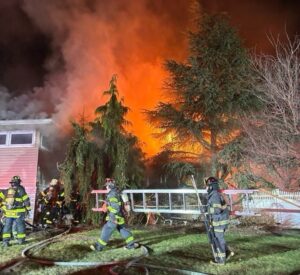EMFD STRESSES ADDITIONAL SAFETY DURING THE HOLIDAYS
| In years past, your several Long Island Fire Departments have responded to serious fires during
the holiday. In some cases, holiday lighting or the holiday tree itself, were the cause. The members of your East Meadow Volunteer Fire Department wish to pass on the following important fire safety message to protect our residents. According to NFPA statistics, from 2016 to 2021, fire departments responded to an average of 160 home fires per year that began from a Christmas tree. These fires caused an average of 2 deaths, and 12 million dollars in damage per year.
The National Fire Protection Association (NFPA) adds that: that began with decorations, excluding Christmas trees. These fires caused an annual average of 4 civilian fire deaths, 33 civilian fire injuries and $14 million in direct property damage. · Electrical distribution or lighting equipment was involved in more than two in five home Christmas tree fires. · Nearly one in five Christmas tree fires were started by lamps or bulbs. Eight percent were started by candles. · Roughly two of every five home Christmas tree fires started in the living room. · Candle fires peak in December and January with 11 percent of candle fires in each of these months. · Thanksgiving is the peak day for home cooking fires, followed by Christmas Day and Christmas Eve. · Year round, one-third (33%) of home decoration fires were started by candles. This jumped to almost half in December when candles started 46% of such fires. Cooking started one-fifth (19%) of decoration fires. · On average, one of every 32 reported home Christmas tree fires result in a death compared · to an average of one death per 143 total reported home fires on the annual average. There are simple life-saving steps you can take to ensure a safe and happy holiday. · By following some of the outlined precautionary tips, individuals can greatly reduce their · chances of becoming a holiday fire casualty. PREVENTING CHRISTMAS TREE and LIGHTING FIRES · A burning tree can rapidly fill a room with fire and deadly gases. · needle should not break if the tree has been freshly cut. The trunk should be sticky to the · touch. Old trees can be identified by bouncing the tree trunk on the ground. If many needles · fall off, the tree has been cut too long, has probably dried out, and is a fire hazard. · dry out the tree, causing it to be more easily ignited by heat, flame or sparks. · Be careful not to drop or flick cigarette ashes near a tree. Do not put your live tree up too · early or leave it up for longer than two weeks. Keep the tree stand filled with water at all times. · When the tree becomes dry, discard it promptly. The best way to dispose of your tree is by · taking it to a recycling center, or having it hauled away by our community pick-up service. · Such opportunity for an undetected fire creates more advanced fire conditions, and gives · little chance to the dedicated volunteers of the East Meadow Fire Department. PURCHASING HOLIDAY LIGHTS · or cracked sockets, and excessive kinking or wear before putting them up. · Use only lighting listed by an approved testing laboratory such as Underwriters · Laboratory (UL). · Many of today’s LED holiday lights use less electric, are cooler, and reduce the threat of · electrical overloads, however, know the limitations to the extent of connecting lights strands. · Make sure to periodically check the wires – they should not be warm to the touch. · immediately. This could be a sign of problems to come.
ABOUT LEAD Our residents need to know, that some of the less expensive wiring that displays holiday lighting may contain lead.. Some states require warning labels for holiday wiring. The presence of lead is not accidental. In some cases lead is intentionally applied to the polyvinylchloride (PVC) coating on the wiring of the lights to prevent the plastic from cracking and crumbling, to protect the string of lights from heat and moisture, and to act as a flame retardant. Alternates to lead do exist, but they tend to be more expensive.
Should you be concerned? To a degree….. Each year in the United States, roughly a quarter million children below the age of six are found to have unsafe levels of lead in their blood. In children, early exposure to lead can cause learning disabilities, behavior issues, speech and language impairment, attention deficit disorder, and growth issues. In adults, lead exposure can cause fertility problems, high blood pressure, digestive, and nerve disorders. This is the bad news.. But the good news is that the actual amount of exposure from our holiday lighting is likely low, unless you’re the kind to handle them often during the year. That being said, you’re much more likely to be exposed to dangerous amounts of lead from lead based paints, and contaminated soils. Nevertheless, when it comes to holiday lighting, professionals recommend that only adults handle them, ideally with gloved hands, and since lead isn’t easily absorbed through the skin, we should make sure to wash our hands thoroughly. Remember: Grabbing that holiday cookie with hands that previously handled holiday lighting puts the contamination at your mouth….. HOLIDAY DECORATIONS chimney fire. CANDLE CARE use a burning candle, make sure they are in stable holders and place them where they cannot be easily knocked down. Never have any combustible materials near, under, or over a lit candle. Never light a candle if you are drowsy or ready to fall asleep. Never leave the house with candles burning. Do not go near a Christmas tree with an open flame candle, lighter, or matches.
ABOUT THE PHOTO This photo, an on line demonstration courtesy of NFPA, shows the fury of a fire caused by a dried out tree. This photo is just 17 seconds into the fire. We cannot stress enough, the dangers of dried out tree. In most single family homes such as found in our community, a Christmas tree is within 12 feet of an open (No Door) staircase to the 2nd floor sleeping quarters. In a fire, this stairway can act as chimney for the smoke, super heated gases, and eventually the fire.. If this video does nothing more, we ask that our residents dispose of your tree when the needles fall, (before branches are brittle), turn off all electric to the tree when retiring, and always, always!, have a working smoke detector on each level of your home at the very least…
EARLY DETECTION level of your home, test them monthly, and keep them clean and equipped with fresh batteries at all times. Know when and how to call for help. (EMFD Emergency Hot Line 516-542-0576). And remember to practice your home escape plan. On behalf of the Board of Fire Commissioners, the Chief’s Office, and members of the East Meadow Fire Department, we wish you, and your family, the safest and happiest holiday season while stressing the urgency for you not to leave holiday fire safety to chance. PHOTO: NFPA STORY: John J. O’Brien Sr [email protected] |





